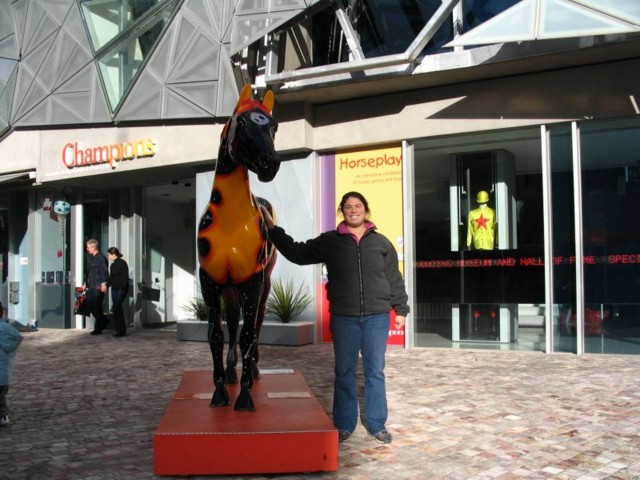
Before we came to Australia, people told us lots of things about Melbourne. There were plenty of people trying to encapsulate the differences between Melbourne and Sydney as the difference between two other cities in the world. These usually provided very vague similes, not really describing anything to anyone other than the person who says them in the first place. If you ask me, if Sydney is like Tel Aviv then Melbourne is like Haifa. Do with this comparison what you will.
More to the point, one has to understand that Melbournians and Sydneysiders see themselves in some eternal popularity melee that has nothing to do with anything other than the fact that competitive sportsmanship is at the very grain of being Australian. We even heard them competing about their respective weather, if you can believe that. It sounded something like this:
Melbourne man exclaims: "Everyone in Sydney keeps saying how much better the weather in Sydney is, but it turns out, when you actually compare figures, Sydney gets more rainfall every year than Melbourne does!"
Sydney man counters: "Sure, but in Sydney all this rainfall comes down over a period of three weeks of every year. In Melbourne it drizzles all year long!"
By the way, the Melbournians hedge their bets on this weather competition at every opportunity. When two Melbournians meet, regardless of what time of day it is, what they have been doing, or how bad the weather really is, the conversation is always exactly so:
One says: "Excellent weather!"
To which the other answers: "I hope it holds!"
I suppose you have to see it to believe it. If you ever want to disguise yourself as a Melbournian, I guess knowing this secret handshake is half the trick.
To give you another clue as of the competition levels between Australia's two largest cities, the contest was so bad that neither was allowed to become the capital of Australia, for fear the other city will take it too badly. Consequently, a completely new town was invented for this purpose. That is Canberra, and we'll go to describe it later on.
Anyway, our stay in Melbourne was short and uneventful. We went to see the central business district on foot, visited the old mint with memories of the gold rush that created Melbourne and saw Federation Square.

This horse, by the way, is set outside "Champions", Melbourne's racing museum, dedicated mainly to the horse along whose contours this statue was shaped. That horse is Phar Lap, a legend in Melbourne and in all of Australia. Throughout the trip, Orit was frantically looking for a colorful statue of a horse that she remembered seeing in Na'ama's Melbourne photographs, and this is the closest we got to finding it.
Federation Square is not just about Champions, mind you. It's got everything and anything crammed into it. There's the Victoria Gallery of Art (they had some pretty nifty exhibitions, but we had very little time for them) and the Moving Image Museum (where they also had some pretty nifty exhibits, and in particular one called "Memory Box", of which I remember nothing.). Across the street you'll find St. Paul's Cathedral (in renovations) and opposite it the oldest pub in Melbourne (Young and Jackson's: we ate there some pretty good meals, but their Oolong tea was overripe.) Then, completing a full circle around the place, you will find Flinders Street railway station, that is spectacular in its own right.
It was all rather boring.
We did quite a bit of touring in the central business district of Melbourne (CBD, as they say in Australian), visiting Cook's cottage and what not, but the only thing that was worth seeing there was the Melbourne Museum, which represents the largest bulk of photographs in the Melbourne gallery. Unfortunately, though, we didn't take any pictures of it from the outside, for you to see the distinctive building it resides in. The front of the building is like two large ramps, both sloping towards the center. These ramps almost look as though you could skateboard down them, which is an idea that probably appeals to the skateboarders of the area, a large number of them were to be seen practicing just in front of the museum.
The fact that we have no outside photographs of this building is not because we didn't like it, but reflects our general mood at the time. Let me explain. The building is located in the middle of Carlton Gardens, right to the north of the Royal Exhibition Building. We came up to the Royal Exhibition Building, which is, well, a nice building, styled roughly like a cathedral, and came across a little plaque that explains that this building is a World Heritage site, recognized by UNESCO. At this point, we let out a long, exasperated sigh: We knew that Australia has more world heritage sites than any other country. We knew that Australia has world heritage sites that gained their status in some odd categories (such as the Uluru, which is recognized both for its geological and for its cultural value), but it was at this point, when we saw the plaque, that we realized that this "more than any other country" is yet another facet of the Australian never-satiated need to out-do everyone else at any sport. Here the sport consisted of having every boulder in every town individually recognized as a world heritage site.
After we saw this, we immediately decided, without saying a word, that we will no longer waste a single bit of camera memory on photographing any more world heritage sites. The camera was unceremoniously stowed away until we were safely within the building of the Melbourne Museum.
One exhibit that you could see immediately as you walked in caught our attention:
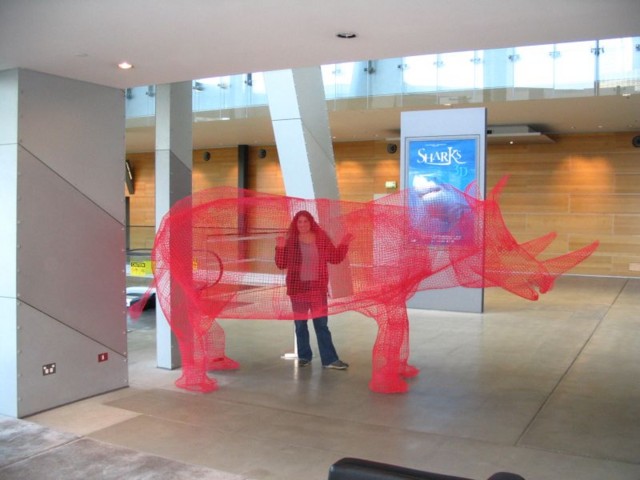
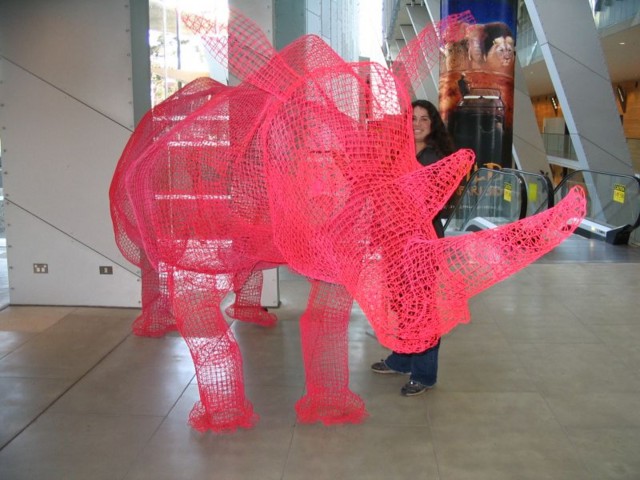
It's truly a very diverse and interesting museum. We spent the whole day there.
Also in the museum complex there was an IMAX theatre, where we saw James Cameron's documentary film "Aliens of the Deep", that speaks about the ecosystems that form near underwater chimneys, channeling water that was heated by lava. Though the ecosystems themselves are fascinating (these are the only known life-forms that don't require solar energy), the movie was boring.
Before seeing it, we had some time to kill, so we went to a nearby Italian restaurant. The restaurant itself was a proud member of the "Slow Food" movement, but thankfully Orit told them to hurry up.
On the way back, we were pleasantly surprised to see some the local wildlife. These are possums:
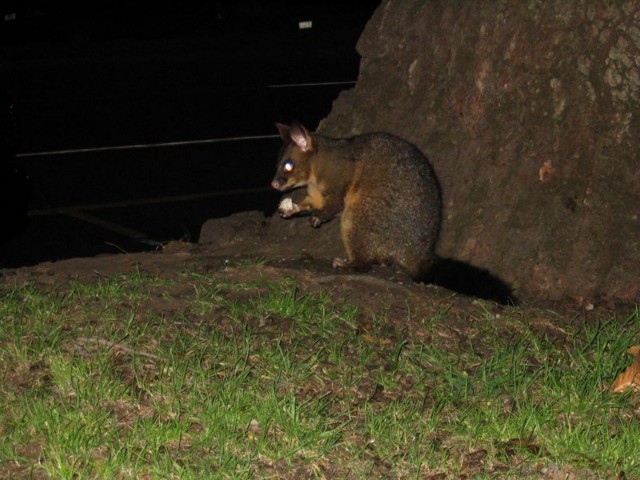
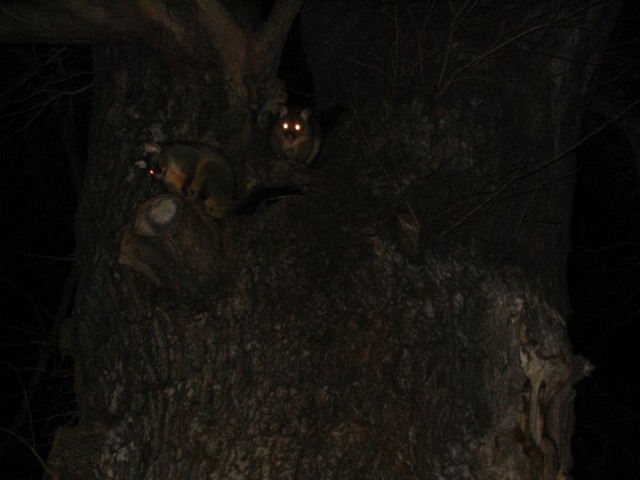
As you can imagine, after three days in Melbourne, we felt like this:
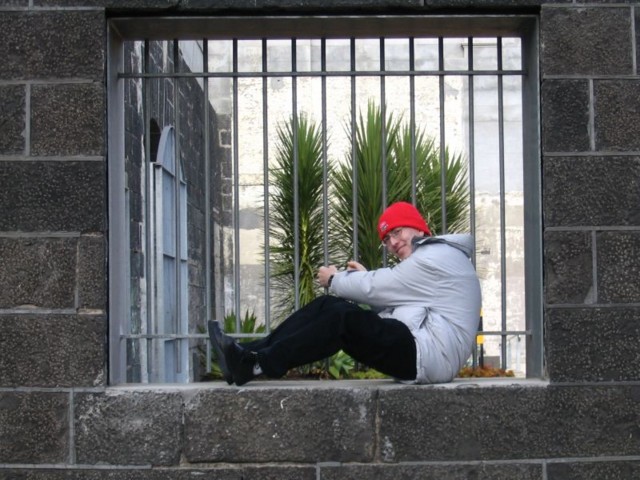
This is, by the way, me, reliving the last few days of the short and wretched life of one highway robber called Ned Kelly, who, for inexplicable reasons, is Australia's number one all-time hero. Couldn't figure this one out. If you can, tell me about it.
The place where the picture was taken is "The Old Gaol", Melbourne's oldest prison, and where Kelly was ultimately hanged.
On our last day in Melbourne, we planned to visit the botanical gardens, but some heavy rain got in our way. We spent the day, instead, in some Arts and Crafts bazaar, and had a swell time. Nevertheless, we felt that the Melbournian weather was getting worse than usual, and that it's time to move on, so that evening we did.